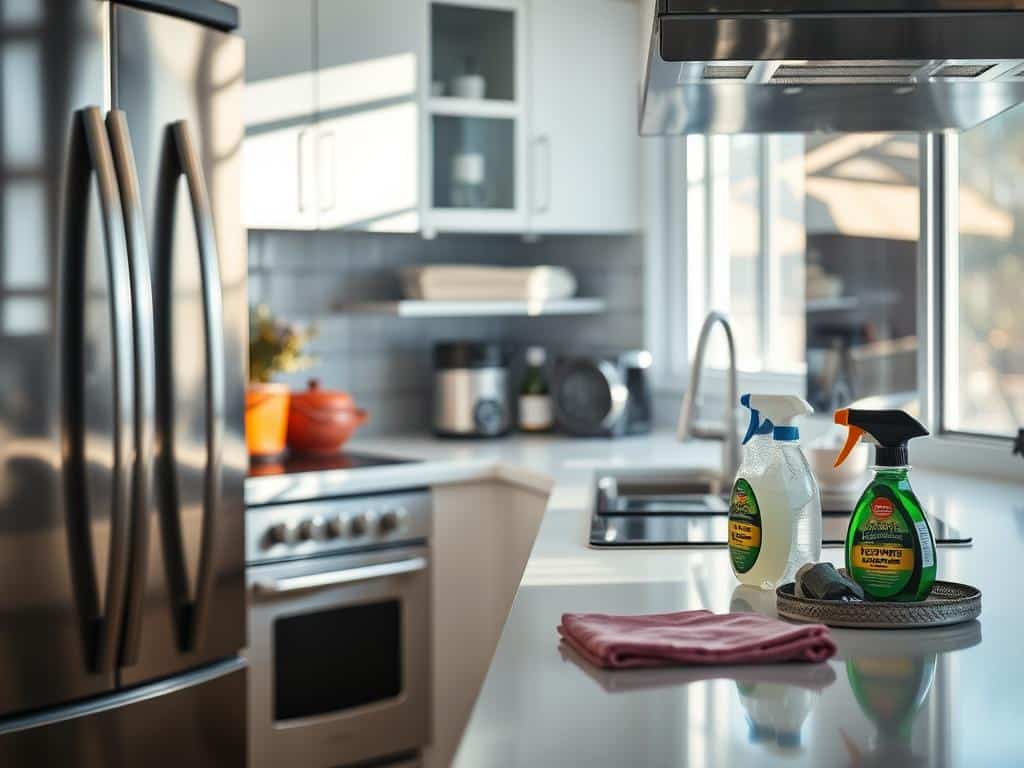
A clean and organized home is possible with a planned cleaning schedule that includes everyone. By creating a family cleaning schedule, chores get shared. This also teaches children good cleaning habits early on.
Simple tasks like making beds, picking up toys, and loading the dishwasher are key. Brown University says these habits should start by age nine. Adding fun and rewards to the routine encourages kids. This makes for a happy, well-run house.
Getting Started with Your Family Cleaning Schedule
Starting a cleaning schedule for the family means planning well. Using things like personalized labels and checklists can help. Avery Design and Print Online (ADPO) offers editable and printable templates to organize chores.
Plan who does what chore in the family. Give simpler tasks to younger kids and more complex ones to older members. This way, everyone helps with cleaning.
Try giving each task a time slot. For example, set 30-minute or 1-hour periods for chores. Arrange specific days for tasks like laundry and vacuuming to keep a routine.
- Do laundry 4 days a week.
- Pick days for vacuuming and cleaning the bathroom.
- Organize clothes with a “Family Closet” system.
Using a “Family Closet” system makes managing clothes easy. Each child’s dresser can have specific drawers for different clothes. Also, plan days for deep cleaning and taking care of the kitchen.
Include an evening routine for tidying up around 4:00-5:00 PM. This helps keep the house clean daily. For children with special needs or autism, such structure can be very helpful. A 30-minute daily cleanup, with 10-15 minutes tasks like mopping, keeps your home neat.
Finally, be ready to change your routine as needed. Flexibility ensures everyone’s happy and the home stays clean.
Daily and Weekly Cleaning Tasks
A clean and organized home is easy to maintain with a good plan. By setting up a daily and weekly cleaning schedule, you make sure cleaning is never too much for one person. Getting the whole family involved means your home stays neat without much effort. Let’s see how to set up these cleaning routines to be effective and easy.

Daily Routine
Having a daily cleaning routine keeps your home in order every day. Spending a little time on chores daily will make your home look and feel better. Here are the main things you should do every day:
- Making the bed
- Wiping down and sanitizing kitchen and bathroom counters
- Loading/unloading the dishwasher
- Doing a nighttime sweep to declutter living spaces
- Sanitizing toilets and sinks
- Managing laundry
By sharing daily cleaning tasks, the whole family helps keep the house clean. This makes everyone’s life easier and keeps your home welcoming.
Weekly Routine
Some cleaning tasks need to be done weekly, not daily. This weekly work keeps your home from getting dirty and cluttered. Here’s what a typical weekly cleaning list looks like:
- Vacuuming and mopping floors
- Dusting surfaces
- Cleaning toilets, bathtubs, and showers
- Wiping mirrors and major appliances
- Kitchen maintenance such as cleaning the backsplash and microwave
- Emptying trash bins
Spread the bigger cleaning tasks across the week to avoid a weekend rush. This way, you can relax and have fun with your family instead of cleaning all weekend. A detailed weekly schedule helps keep every part of your home clean and cozy.
Creating a Personalized Cleaning Routine for Families
Creating a cleaning schedule for your family can make life easier and more comfortable. Making a custom cleaning plan means looking at what each family member needs. Then, decide what tasks are most important and how often they should be done.
Every family is different, so a personalized chore list can help avoid messes. Having morning and night routines works well. Doing simple things like making beds, wiping counters, and doing dishes keeps your home neat every day.
Mixing daily, weekly, and monthly chores is key to a clean home. Daily tasks prevent clutter. Weekly jobs like vacuuming and cleaning the bathroom are for deeper cleans. And monthly tasks, like window washing, make sure nothing is forgotten. Also, plan seasonal cleanups, such as organizing the basement, for a well-maintained home.
Keep your kitchen tidy by cleaning as you go and wiping surfaces regularly. Tackle one room at a time for deep cleaning. Getting the whole family involved and having a clear schedule makes big cleans easier.
With a good routine, balancing cleaning and free time is easy. Spend about 30 minutes each night on small tasks to keep your home tidy. Technology, like robot vacuums, and the right cleaning products can boost your efficiency. A personalized cleaning list that matches your family’s life makes your routine work well.
A survey shows 75% of families do daily chores like making beds. Yet, 60% think weekly cleaning is hard, and 45% find doing tasks every few weeks tough. About 80% use tools like lists or apps for organizing chores, showing that a good plan helps a lot.
Keeping Children Engaged in the Cleaning Process
To get kids into cleaning, make it fun. Turn chores into games that catch their interest. This way, cleaning feels more like playtime and less like work.
Make It Fun
Try “The Cleaning Race” or “Chore Bingo” to spice up chores. Use DIY charts or checklists from Etsy to keep them excited. Rewards like stickers or extra screen time add to the fun. The University of Minnesota says this approach builds kids’ self-worth and responsibility.
Making chores a game leads to better involvement. Adding competition or rewards makes cleaning fun. It helps kids learn important values.
Teach Responsibility
Teaching kids to clean is crucial for their development. Give bigger tasks to older kids and simpler ones to younger kids. Checklists help them take charge of their chores, and swapping tasks teaches leadership. Rewards encourage them to own their chores.
Clear roles make kids more accountable. Families with a cleaning plan keep their kitchens cleaner. Working together makes your home neater and strengthens family bonds. Early teamwork skills come from family cleaning efforts.
Assign tasks by age to promote consistency in cleaning habits. For example:
| Age Group | Tasks | Duration |
|---|---|---|
| 2-3 years | Putting away toys | 5 minutes |
| 6-8 years | Picking tasks like dusting or sweeping | 20-30 minutes |
| 10+ years | Extensive tasks such as washing bed sheets | 30+ minutes |
This approach turns cleaning into a positive habit. It teaches kids responsibility and teamwork. And it makes chores enjoyable for the whole family.
Conclusion
Creating a good cleaning schedule for families needs careful planning, methods that fit your family, and everyone’s participation. With a good plan for keeping the house clean, your home can become a place where chores are part of every day. This makes life more organized.
Kids as young as toddlers can help by picking up their toys. Teenagers can do bigger jobs like washing clothes or cooking. Getting kids involved teaches them to be responsible. It also helps them learn important skills like managing their time and working hard.
A strong cleaning routine makes your home tidy and less stressful. It brings your family closer. When everyone does their part, things run smoothly. Talk to your kids about chores, give clear instructions, and praise their efforts. This makes everyone feel they are working together. Try these tips to keep your home clean and enjoy a happier, more peaceful life together.



